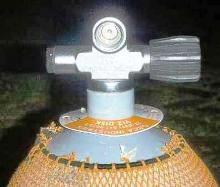Home › Diving › Free Lessons › Safety Tips › Tank Valves
Tank Valves - A Wrong Turn Can Be Fatal
Running out of air during a scuba dive is frightening at best and fatal at worst.
Unexpectedly empty scuba cylinders and sudden air supply failings relate to divers’ most scary underwater nightmares.
The immediate response to this failure or malfunction is to secure an alternate air source from your dive friend or tour guide.
We assume that you regularly check your pressure gauge while diving and have your scuba equipment professionally serviced as per the manufacturer’s instructions.
Therefore, what causes this kind of failure most often and why do some pressure gauges indicate that the tank is around half-full at the time of breathing difficulty?
How do you open your scuba tank valve before your dive?
Most recreational divers slowly turn the cylinder valve fully open anticlockwise and then back a one-quarter (¼) turn.
The justification for this fractional turning procedure is to reduce the likelihood of the valve sticking in the open position after high-pressure air has entered the assembly.
Curiously, I learnt this method twenty years ago yet astonishingly I cannot see the instructions for this technique in the PADI Open Water Diver manual. The PADI scuba book instructs divers to 'open the valve fully' without any mention of the turn partway back.
It may seem sensible and rational to avoid a sticking tank valve; however, a recent US article blames this dangerous procedure for the tragic death of a diver who had two-thirds air supply remaining inside the cylinder (140 bar/2,000 psi).
 Fatefully, his tank valve was open only one quarter of a full turn.
Fatefully, his tank valve was open only one quarter of a full turn.
Similar incident reports and articles suggest that some divers are mistakenly beginning the dive with the valve only partially open from the closed position.
They wrongly assume the tank is fully open because the regulator supplies some air at the surface. The air fails at depth unless the valve is fully open.
This starvation exaggerates if the diver descends upside down.
Fatalities and survivors from this potentially dangerous practice have strongly influenced the current standards in cave and technical diving. The reaffirmed recommendation is to fully open tank valves or fully close them.
Strangely, these guidelines have not yet become standard in recreational diving.
Cylinder Valves Industry Standards
The heating, ventilation, and air conditioning (HVAC) and welding industrial equipment advice suggests never fully opening a valve assembly. Their concern is over forcing a valve if it is already in its open position can cause damage to the operational parts.
It is a contentious analogy but acetylene-welding bottles are unlikely to function when partially opened and you are unlikely to die.
Nevertheless, the fact is, an incorrectly opened scuba cylinder valve is potentially fatal. Partially opened valves can deliver sufficient air at shallow depths but as the diver descends, the gas can dry up.
We agree that forcing valves beyond the appropriate stopping position in any direction is poor advice, but divers cannot damage most modern scuba valves under normal use.
We conclude the analysis by confirming that scuba instructors do not advise you to close valves completely and then open it a quarter turn before you store the unit.
Opening and Closing Tank Valves
You should open and close tank valves slowly, very gently turning the screw knob until it has completely opened or fully closed.
Stop turning the turn-wheel if you feel any resistance during the procedure and report it to an equipment service technician.
Inhale several deep breaths through the regulator and observe your pressure gauge. The reading from your gauge or needle should be stable and solid.
Twitching movement from your gauge needle synchronizing with your breaths indicates that you have a partially open valve.
If the valve is entirely closed, the pressure drops with each breath until the system has purged the air. Be sure to open the valve fully open before you dive.
Securing valves at the stop position helps to avoid the dangerous situation of mistaking a partially opened valve and unintentionally closing the air supply.
You should also be aware that your dive buddies and dive guides might inadvertently create a problem for you. They make mistakes too.
Colour Coded Vindicator Valve Knob
A new patented device is helping divers and their dive buddies verify - at a glance - whether a scuba tank valve is in the open or closed position!
This section explains how Vindicator Safety Valve Handles work and how to fit a new replacement assembly yourself.
Diving Underwater Hazards |> Scuba Diving Fatality Rate |> Decompression Illness |> Divers Disease 'The Bends' |